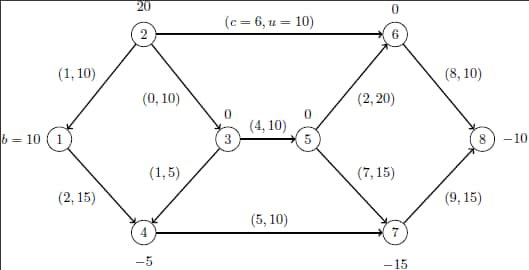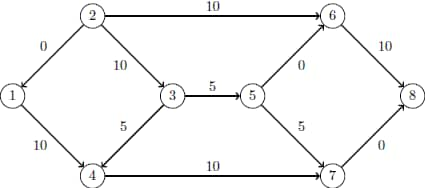The OPTLP Procedure
- Overview
- Getting Started
-
Syntax

-
Details
 Data Input and OutputPresolvePricing Strategies for the Primal and Dual Simplex SolversWarm Start for the Primal and Dual Simplex SolversThe Network Simplex AlgorithmThe Interior Point AlgorithmIteration Log for the Primal and Dual Simplex SolversIteration Log for the Network Simplex SolverIteration Log for the Interior Point SolverIteration Log for the Crossover AlgorithmConcurrent LPODS TablesIrreducible Infeasible SetMacro Variable _OROPTLP_
Data Input and OutputPresolvePricing Strategies for the Primal and Dual Simplex SolversWarm Start for the Primal and Dual Simplex SolversThe Network Simplex AlgorithmThe Interior Point AlgorithmIteration Log for the Primal and Dual Simplex SolversIteration Log for the Network Simplex SolverIteration Log for the Interior Point SolverIteration Log for the Crossover AlgorithmConcurrent LPODS TablesIrreducible Infeasible SetMacro Variable _OROPTLP_ -
Examples

- References
Example 10.8 Using the Network Simplex Solver
This example demonstrates how to use the network simplex solver to find the minimum-cost flow in a directed graph. Consider the directed graph in Output 10.8.1, which appears in Ahuja, Magnanti, and Orlin (1993).
Output 10.8.1: Minimum Cost Network Flow Problem: Data

You can use the following SAS statements to create the input data set ex8:
data ex8; input field1 $8. field2 $13. @25 field3 $13. field4 @53 field5 $13. field6; datalines; NAME . . . . . ROWS . . . . . N obj . . . . E balance['1'] . . . . E balance['2'] . . . . E balance['3'] . . . . E balance['4'] . . . . E balance['5'] . . . . E balance['6'] . . . . E balance['7'] . . . . E balance['8'] . . . . COLUMNS . . . . . . x['1','4'] obj 2 balance['1'] 1 . x['1','4'] balance['4'] -1 . . . x['2','1'] obj 1 balance['1'] -1 . x['2','1'] balance['2'] 1 . . . x['2','3'] balance['2'] 1 balance['3'] -1 . x['2','6'] obj 6 balance['2'] 1 . x['2','6'] balance['6'] -1 . . . x['3','4'] obj 1 balance['3'] 1 . x['3','4'] balance['4'] -1 . . . x['3','5'] obj 4 balance['3'] 1 . x['3','5'] balance['5'] -1 . . . x['4','7'] obj 5 balance['4'] 1 . x['4','7'] balance['7'] -1 . . . x['5','6'] obj 2 balance['5'] 1 . x['5','6'] balance['6'] -1 . . . x['5','7'] obj 7 balance['5'] 1 . x['5','7'] balance['7'] -1 . . . x['6','8'] obj 8 balance['6'] 1 . x['6','8'] balance['8'] -1 . . . x['7','8'] obj 9 balance['7'] 1 . x['7','8'] balance['8'] -1 . . RHS . . . . . . .RHS. balance['1'] 10 . . . .RHS. balance['2'] 20 . . . .RHS. balance['4'] -5 . . . .RHS. balance['7'] -15 . . . .RHS. balance['8'] -10 . . BOUNDS . . . . . UP .BOUNDS. x['1','4'] 15 . . UP .BOUNDS. x['2','1'] 10 . . UP .BOUNDS. x['2','3'] 10 . . UP .BOUNDS. x['2','6'] 10 . . UP .BOUNDS. x['3','4'] 5 . . UP .BOUNDS. x['3','5'] 10 . . UP .BOUNDS. x['4','7'] 10 . . UP .BOUNDS. x['5','6'] 20 . . UP .BOUNDS. x['5','7'] 15 . . UP .BOUNDS. x['6','8'] 10 . . UP .BOUNDS. x['7','8'] 15 . . ENDATA . . . . . ;
You can use the following call to PROC OPTLP to find the minimum-cost flow:
proc optlp presolver = none printlevel = 2 logfreq = 1 data = ex8 primalout = ex8out algorithm = ns; run;
The optimal solution is displayed in Output 10.8.2.
Output 10.8.2: Network Simplex Solver: Primal Solution Output
| The OPTLP Procedure |
| Primal Solution |
| Obs | Objective Function ID |
RHS ID | Variable Name | Variable Type |
Objective Coefficient |
Lower Bound |
Upper Bound | Variable Value |
Variable Status |
Reduced Cost |
|---|---|---|---|---|---|---|---|---|---|---|
| 1 | obj | .RHS. | x['1','4'] | D | 2 | 0 | 15 | 10 | B | 0 |
| 2 | obj | .RHS. | x['2','1'] | D | 1 | 0 | 10 | 0 | L | 1 |
| 3 | obj | .RHS. | x['2','3'] | D | 0 | 0 | 10 | 10 | B | 0 |
| 4 | obj | .RHS. | x['2','6'] | D | 6 | 0 | 10 | 10 | B | 0 |
| 5 | obj | .RHS. | x['3','4'] | D | 1 | 0 | 5 | 5 | U | -1 |
| 6 | obj | .RHS. | x['3','5'] | D | 4 | 0 | 10 | 5 | B | 0 |
| 7 | obj | .RHS. | x['4','7'] | D | 5 | 0 | 10 | 10 | B | -4 |
| 8 | obj | .RHS. | x['5','6'] | D | 2 | 0 | 20 | 0 | L | 0 |
| 9 | obj | .RHS. | x['5','7'] | D | 7 | 0 | 15 | 5 | B | 0 |
| 10 | obj | .RHS. | x['6','8'] | D | 8 | 0 | 10 | 10 | B | 0 |
| 11 | obj | .RHS. | x['7','8'] | D | 9 | 0 | 15 | 0 | L | 6 |
The optimal solution is represented graphically in Output 10.8.3.
Output 10.8.3: Minimum Cost Network Flow Problem: Optimal Solution

The iteration log is displayed in Output 10.8.4.
Output 10.8.4: Log: Solution Progress
| The OPTLP Procedure |
| NOTE: The problem has 11 variables (0 free, 0 fixed). |
| NOTE: The problem has 8 constraints (0 LE, 8 EQ, 0 GE, 0 range). |
| NOTE: The problem has 22 constraint coefficients. |
| NOTE: The LP presolver value NONE is applied. |
| NOTE: The LP solver is called. |
| NOTE: The Network Simplex algorithm is used. |
| NOTE: The network has 8 rows (100.00%), 11 columns (100.00%), and 1 component. |
| NOTE: The network extraction and setup time is 0.00 seconds. |
| Primal Primal Dual |
| Iteration Objective Infeasibility Infeasibility Time |
| 1 0 20.0000000 109.0000000 0.00 |
| 2 0 20.0000000 109.0000000 0.00 |
| 3 5.0000000 15.0000000 104.0000000 0.00 |
| 4 5.0000000 15.0000000 103.0000000 0.00 |
| 5 75.0000000 15.0000000 103.0000000 0.00 |
| 6 75.0000000 15.0000000 99.0000000 0.00 |
| 7 130.0000000 10.0000000 96.0000000 0.00 |
| 8 270.0000000 0 0 0.00 |
| NOTE: The Network Simplex solve time is 0.00 seconds. |
| NOTE: The total Network Simplex solve time is 0.00 seconds. |
| NOTE: Optimal. |
| NOTE: Objective = 270. |
| NOTE: The data set WORK.EX8OUT has 11 observations and 10 variables. |